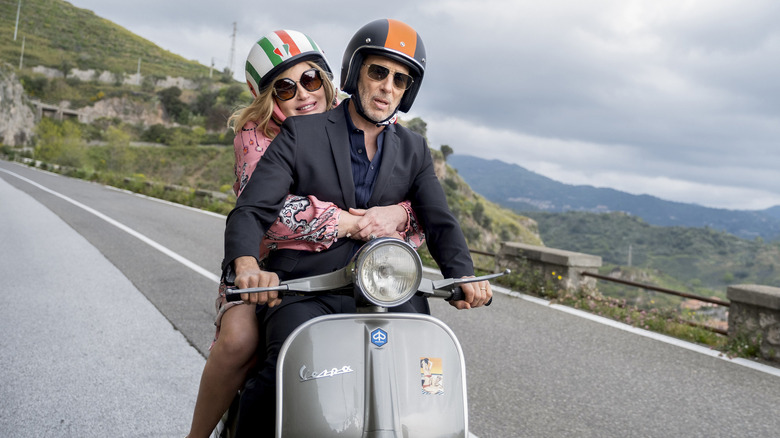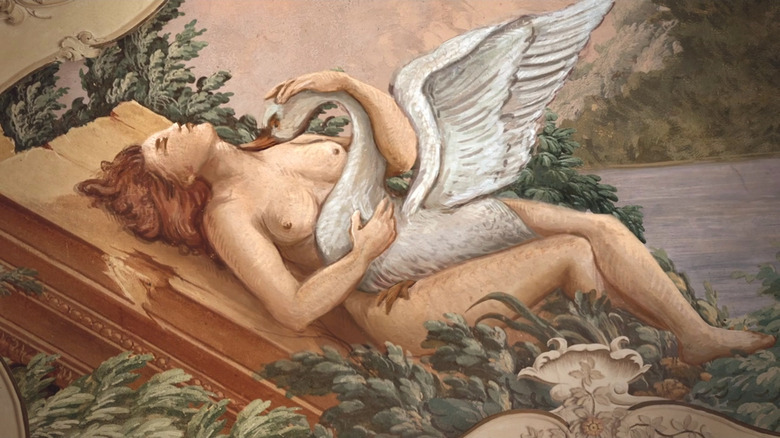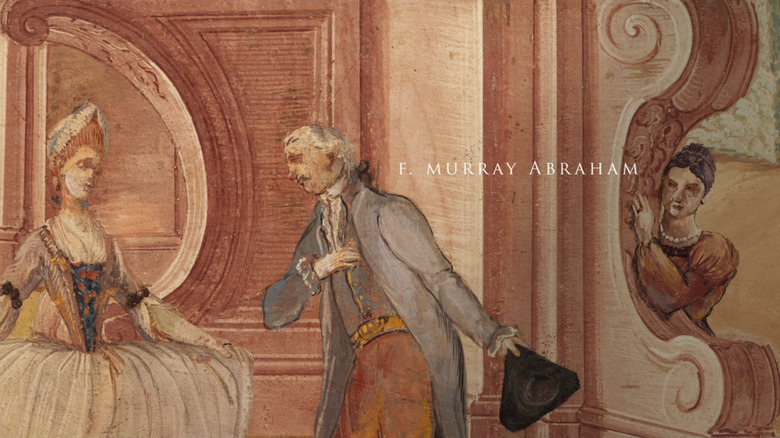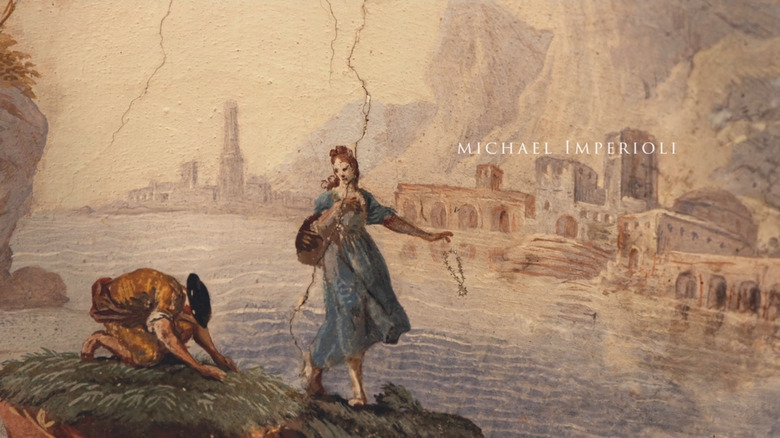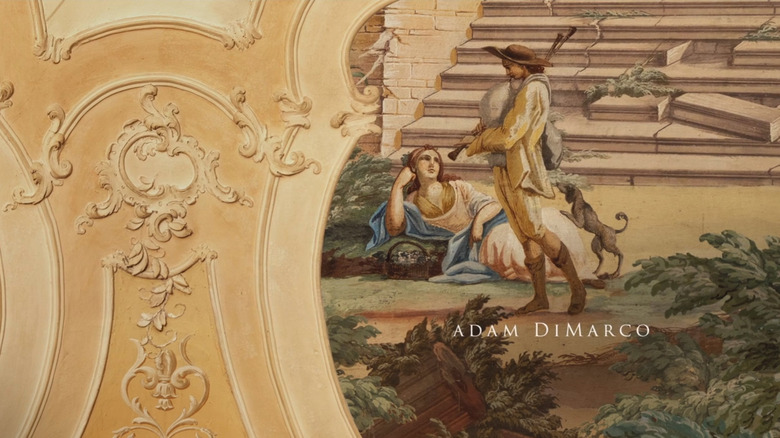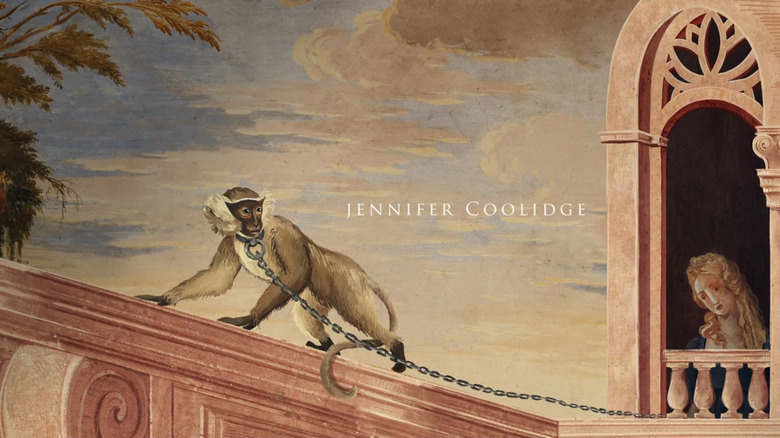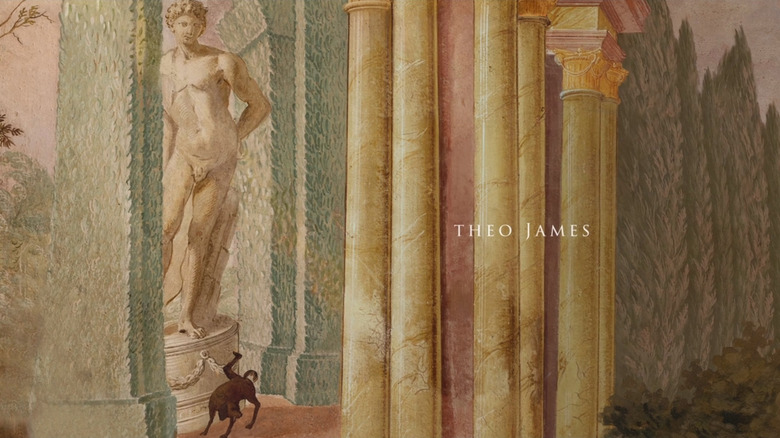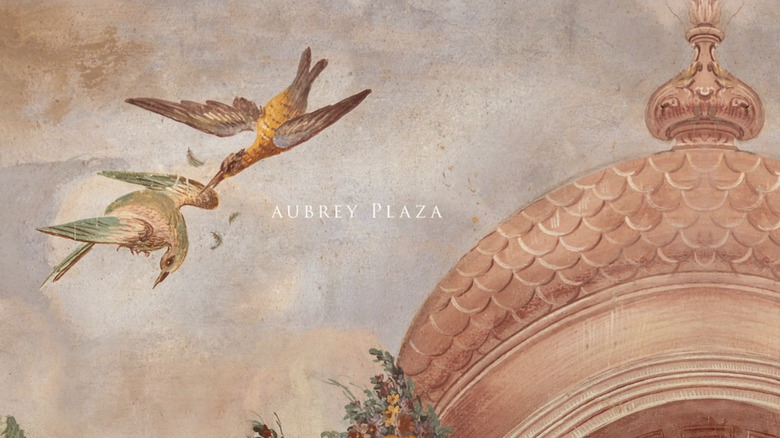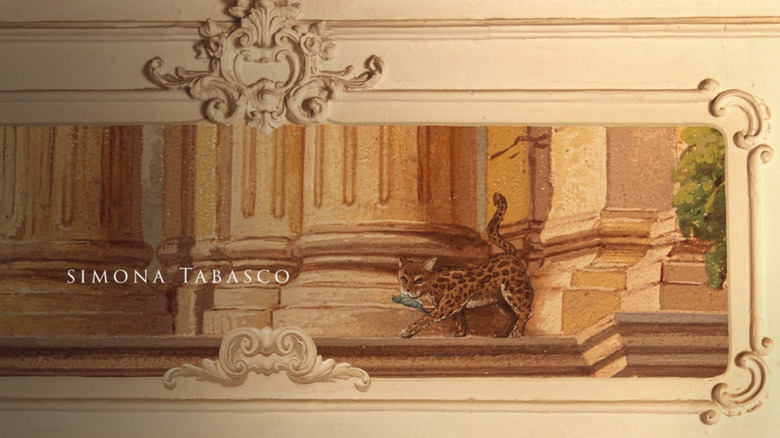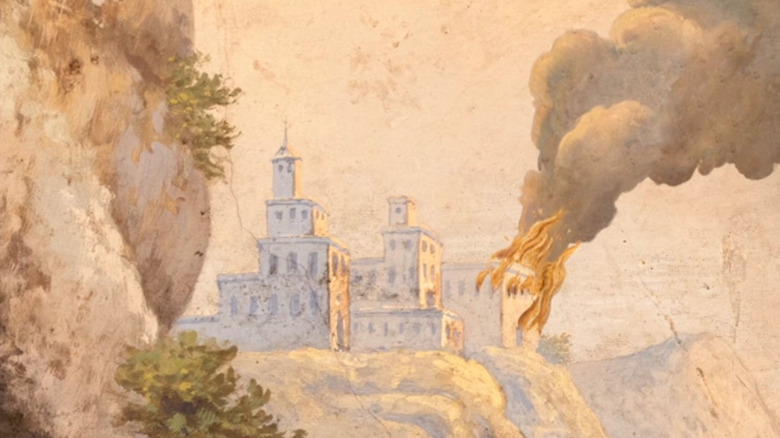Unpacking The Secrets Of The White Lotus Opening Credits
In some ways, the second season of "The White Lotus" is exactly the same as the first. We once again have signed on for a stay at the titular resort where we'll spend 7 weeks watching the filthy rich guests spiral into madness, verbally spar with one another, and put their very worst selves on display. All the while, their so-called peaceful getaway will become a nightmarish stay that ends with at least one dead body. But the difference is in the details. We have a new crop of guests and with them, series creator Mike White is taking his scathing commentary in a slightly different direction.
Instead of skewering the wealthy elites through the lens of tourism and colonization, season 2 has set its sights on sexual politics — a thorny subject matter no matter which way you approach it. So naturally, "The White Lotus" needed a bit of a makeover — and I'm not talking about the switch from Hawaiian paradise to sun-soaked Sicily. Mike White has dubbed this new chapter "a sex comedy with teeth," and made sure to pair it with an elaborate opening sequence that befits the season's horny and murderous tendencies. So if you're looking to understand this show to its core, then look no further than the first 90 seconds of every episode — all the secrets of "The White Lotus" season 2 are hidden in the opening credits.
What lies beneath the surface?
The opening visuals of "The White Lotus" season 2 were created by Katrina Crawford and Mark Bashore, the same masterminds behind season 1's lavish sequence. Where the Hawaiian excursion offered tropical-themed wallpaper adorned with rotting fruit and blood splatters, the second outing of "The White Lotus" embraces its Sicilian roots with Italian frescoes. But artistic flourishes and detailed portraits are just the tip of the iceberg when it comes to this artwork — these frescoes are uniquely depraved.
Much like the White Lotus guests, the surface-level beauty is just for show. When the 90-second segment opens, we're treated to a stunning composition from Cristobal Tapia de Veer, a twist on the season 1 opener that purposely emulates an Italian opera. Meanwhile, the accompanying imagery — a Romanesque fresco — seems to present us with the tale of romantic courtship. But spend a moment longer in this world and you realize what lies beneath the surface: cracks in composure, festering darkness, and yup, even some bloodshed. Is that a villa burning in the distance? A hunter murdering a boar? And who is that in flagranté behind a column?
By the time the opening reaches its feverish, chaotic high, the melodic soprano ad her accompanying harp are nowhere to be found. The vocals have become distorted and the pace has accelerated.
But here's the kicker: every image — and particularly their timing to the actors being credited — is purposeful. They provide hints at who these characters really are and where their storylines are headed. Given the fact that we know the season ends with not one, but a collection of corpses, could the opening sequence also offer a hint about who it may be? We'll have to dig deep to figure that out.
The danger of the DiGrasso's
As the credits roll, Tapia de Veer's "Renaissance" begins with a harp, a gentle soprano, and a romantic engagement: a debonair man tipping his hat to a beautiful young woman. Seems nice, right? Except for the fact that right around the corner, hidden from their view, another woman is watching it go down. Much closer to the man's age, she wears a wedding ring and a look of disdain. It seems like infidelity is the name of this game, so it's no wonder that F. Murray Abraham's name appears onscreen, connecting this moment to Bert — the womanizing patriarch of the Di Grasso clan.
In its first two episodes, "The White Lotus" has revealed Bert as a walking, talking representation of old-timey misogyny. Despite decades spent cheating on his wife, Bert assumes all was well since she never divorced him. Now that she's dead, he spends every other breath openly harassing *cough* flirting with the women he encounters. But Bert's toxicity turns out to be a single piece of a very irritating portrait: because in reality, all three of the Di Grasso men are horrifically toxic.
Like father, like son
Michael Imperioli's Dominic Di Grasso is sexist in a different way than his father. While he doesn't openly flirt with their waitress at dinner, there's a good reason he's earned the scorn of the family's women. Just like his father, Dominic has been unfaithful — but he made the mistake of getting caught. Fittingly, Imperioli's name appears as a man bows before a woman who walks away from him, tossing a necklace into the ocean.
It illustrates his devastation at being left by his wife, but the cracks in the fresco remind us that it's a much more complicated situation. While Dominic may see himself as the tragic figure still trying to save his marriage, the man can't even get through a weeklong vacation without propositioning the first sex worker he lays his eyes on. So much for salvaging his marriage to the great Laura Dern.
Hidden in plain sight
And then there's Albie (Adam DiMarco), the nepotism baby/Stanford grad who fancies himself a savior to women. When DiMarco's name appears onscreen, it's accompanied by a painting of a young musician, performing for the pleasure of a woman who lazes in the grass. What else might we expect from the "nice guy" who's been clinging to Portia (Haley Lu Richardson) since he first caught her crying on the phone? At first glance, there's nothing of concern in this image. But behind the musician, a dog paws at the woman's dress — a hint that Albie isn't as kind as he seems.
The dog will appear elsewhere in the opening sequence, seeming to represent primal male desire. It makes perfect sense as a hidden red flag for Albie's character. While he seemed nice enough at first, his persistent pursuit of Portia and his desire to be her savior is becoming pretty damn icky. It's not the blatant misogyny of his grandfather or even the regretful selfishness of his father. Albie sees himself as outside of the problem entirely. At first, the audience does too. But by the time he tells Portia that he has a thing for women who are "pretty wounded birds," we know better.
Tanya McQuoid: the captive or the captor?
When Jennifer Coolidge's name appears onscreen, we see a woman in a tower, staring forlornly out a window as a chained monkey climbs to his escape. Which of these is Tanya? "The White Lotus" wasted absolutely no time telling us what has become of the McQuoid-Hunt marriage: Tanya is anxious and insecure about the state of their relationship and Greg (Jon Gries) has dejectedly checked out. He can't be bothered to answer her texts, show any affection or do anything besides complain about how many macaroons she ate.
Neither of them seems very happy, but neither is considering divorce. Tanya is bound by her own desire to make things work and Greg? Well, how can he abandon the women who has bankrolled his medical recovery? But this image floats the possibility of one of them breaking free. SO is Tanya doomed to watch Greg escape while she languishes in a castle (tragic, I know), or will she find a way out on her own terms?
Another glimpse of this couple is shown when Jon Gries gets his credit. Mirroring his Vespa ride with Tanya, the fresco shows a couple riding off into the sunset... on a donkey. The best part is, of course, the donkey, who looks back and breaks the fourth wall. He sees through the farce of this relationship, as do we. Maybe if Tanya wises up too, she'll be the one to off her awful husband.
Two couples = twice the drama
Speaking of couples, there's also the vacationing quartet of the Sullivans and the Spillers. Meghann Fahy's vapid stay-at-home trophy wife is introduced with the image of cherubs. The cupids may project innocence on the outside, but there's a mischievous nature beneath that appearance. Harper (Audrey Plaza) has already assumed this about Daphne (Fahy), refusing to believe that her marriage is as easy as she lets on. It's not exactly hard to understand that suspicion: Cameron (Theo James) seeks to dominate every single interaction he has.
In the first two episodes, Cameron relishes in his alpha male dynamic with Ethan and when alone with Harper, flaunts his sexual power. Naturally, his visual is a nude statue being peed on by a dog. It works on so many levels — the refined version of Cameron being destroyed by his primal urges; the fact that the flashing dog mirrors his own efforts to flash Harper in the mirror; and the general idea of marking one's territory. Cameron is all aggression, bravado, and overconfidence. But Daphne isn't necessarily ignorant to any of that — she just seems great at playing her part.
Murder in the air
As for Ethan, his fresco is decidedly less aggressive — a man making offerings to a goddess. It's a fitting image for the man who struggles to order what he wants at dinner, simply bending to the will of his wife's demands. Speak of the devil, Aubrey Plaza's name is plastered over the image of two birds, one of which is tearing the other apart.
So while Ethan continues deferring power to his wife, who is she on the verge of lashing out at? The possibilities are endless. The Harper we've come to know can be harsh and judgmental, particularly when she's in the company of wealthy elites whom she looks down on. Ethan is certainly an option — she seems concerned that his newfound wealth will change him, especially when in the company of Cameron. But then there's the Sullivans themselves.
Harper has been picking apart the Sullivan marriage from the start — partially because she thinks they're ignorant and terrible, but Ethan seems to wonder if she might also be threatened by their "perfect" relationship. With those two getting along easily, claiming to never fight, and having loud sec n the other side of the wall, it's no wonder the Spiller marriage is getting tense. The idea of Harper losing her s*** by the end of the season seems inevitable — but will she take it out on the Sullivans, her husband, or someone else entirely?
The local danger
The White Lotus guests aren't the only ones with the potential to cause complete and utter chaos. Don't forget about all the pesky locals, who are perfectly capable of creating conflict all on their own. Sabrina Impacciatore plays Valentina, the irritable hotel manager with a tendency to snap at her employees. Her fresco involves a bunch of toga-clad women — one of which is an obvious authority figure, one her way to reprimand the lounging ladies. It harkens back to the way she responds to Lucia (Simona Tabasco) and Mia (Beatrice Grannò), who she immediately guesses are sex workers and tries to keep from the guests.
This might be wishful thinking, but maybe this is an 'if you can't beat them, join them' scenario — maybe Valentina will come around to the local girls and don a metaphorical toga of her own. Or maybe she'll finally find a way to keep them out of her resort.
That would be quite a feat though because the frescoes for these women are powerful symbols. Grannò's Mia boasts a griffin. The mythical beast of power is perched high in the sky, overlooking everything. Meanwhile, Tabasco's Lucia is a leopard on the prowl, already somewhat satiated by a bird caught in its teeth.
After its first season, "The White Lotus" concluded with the bleak note that none of the wealthy elites were ever in any real danger of death. It was a local worker who ended up in a body bag. Between that precedent and the troubling trope of sex workers ending up dead, I've been pretty worried about what the future holds for Lucia and Mia. But if these frescoes are any indication, then they're more than equipt to handle danger — a griffin and a jungle cat? It's everyone else who should be nervous about them.
Trouble in paradise
Not all of the White Lotus guests have checked in. Two main cast members have yet to enter the fray, leaving two wild cards on the table for later: Tom Hollander's Quentin and Leo Woodall's Jack. Both of their murals show men lounging in the presence of other men. For Jack, they hide among the columns, and for Quentin, they live luxuriously.
Once the character introductions are taken care of, the beat drops, and "The White Lotus" opening truly devolves into chaos. First off, things get hornier: covert sex, copulating goats, and a grown man being breastfed, to name a few. But sex is just one half of the madness — the other is violence. A hunter strikes down a boar and a recently stabbed man is thrown down some stairs. Elsewhere, one man stands behind another, reaching into his pocket as if to grasp a concealed weapon. All of this hints towards the idea that this season's deaths won't be absurd accidents (RIP Armond), but outright murders. Betrayal is very much on the table and if anyone whips out a dagger, the alarm bells better ring.
Here's another pivotal image: atop a mountain, a villa burns while ships depart an island. This harkens back to the season one finale when the guests caused devastation before boarding their planes and leaving smoldering remains in their wake. Are the White Lotus locals doomed once more? Or will they be the ones to suffer this fiery fate?
